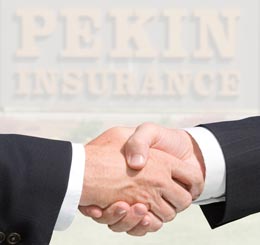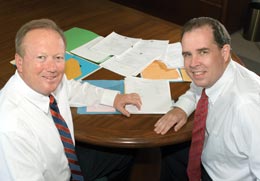|
Insurer/reinsurer symbiotics Pekin and GE Insurance Solutions achieve a 78-year relationship By Michael J. Moody, MBA, ARM
In today’s business environment, one person alone can accomplish very little. As a result, we are called on periodically to partner with colleagues, vendors, and/or customers. And for the most part, in order to maximize the working relationship, there must be a high level of trust and collaborative effort. The trouble is that, despite the buzz that surrounds the relationship concept today, the insurance industry has many built-in impediments to long-term relationships. The whole competitive bidding/pricing process, that is both a mainstay and bugaboo of our industry, appears to be counter to the whole relationship-building concept. Regardless, we should all strive to develop and maintain long-term working relationships. In order to accomplish this goal, it may be beneficial to review some of the key aspects of a good partnership. We talked to two long-term partners in one of the most critical relationships in our industry—the partnership between insurer and reinsurer. Two organizations that share a special insurer/reinsurer relationship are Pekin Insurance Company and GE Insurance Solutions (GE). This partnership began when Pekin Insurance, a regional property/casualty insurer located in Pekin, Illinois, purchased its first reinsurance contract from Employers Reinsurance Corp., which today is part of the GE Insurance Solutions family of companies. The original reinsurance policy carried a $25,000 limit of liability and was dated October 1, 1928. That’s right; 78 years ago, these two organizations forged a partnership that has weathered everything from the Great Depression to 9/11. And it continues to grow stronger with each passing year. Relationships 101 Two of the current principals to this relationship are Steve Nunan, senior vice president-underwriting for Pekin Insurance and Martin Dempsey, assistant vice president/account manager, North American direct P&C reinsurance, GE Insurance Solutions. Each talked about the special bond that their companies share and the partnership that has developed. Their observations regarding their working relationship provide excellent insight into what makes a successful alliance and a great checklist to help your relationships last 78 years. Dempsey notes that the foundation for a good working relationship is that it “has to be built around mutual respect and trust which fosters open and honest communications.” Among other things that he believes are important are “the need to listen to your customer,” so that you can better understand their business. “You should find out what keeps them awake at night,” and assist them in resolving any problems they might have. Nunan adds that, “the relationship should be based on shared visions with partners who have similar core values.” Nunan also notes the similarities between a good business relationship and a good personal relationship. He says that in either case, “you must trust your partner, keep open lines of communications, and maintain an appropriate degree of flexibility. Give-and-take is required by both parties to succeed.” He points out that relationships fail when any of these basic elements are missing. Value-added services
Obviously pricing is an important issue in any insurer/reinsurer relationship, but both Dempsey and Nunan realize that the reinsurance premium will not always be the lowest in the market. Rather, they say that the premium should be competitive, but consistent. More importantly, as Dempsey points out, “the pricing needs to reflect the individual experience and exposures of the particular insurer, rather than the industry as a whole.” Nunan indicates, “in addition to rate levels being based upon individual characteristics of the company, pricing should be reflective of the marketplace and should be of a consistent nature.” Other things that are important to Pekin are the financial strength and stability of the reinsurer. Pekin also considers how long the reinsurer has been in business as well as what its prospects are for the future. Bottom line, Nunan says, “can they meet their obligations and pay their claims in a consistent and timely manner?” With the recent rash of downgrading going on in the insurance industry, Nunan says that a reinsurer’s rating is a very important consideration. He notes it is important to Pekin as well as its policyholders. But in this day and age, insurers expect more than just the basics. “The ability to provide basic services is critical to building a strong relationship,” says Dempsey. “But on top of the traditional services that insurers have come to expect such as prompt claims payments and timely quotes, GE offers its insureds a variety of value-added services that we feel will help the insurer run its business more effectively and more profitably.” Among the more popular services that GE offers its customers are underwriting and claims audits, actuarial support, and access to select market intelligence. As an example, Nunan notes that Pekin has recently been considering expanding into two additional states. He says that GE was able to offer “detailed studies and analysis of the two new markets.” This was information that was very helpful in assisting Pekin to determine a proper course of action. In addition to the above noted services, GE also offers its customers value-added-services that help its customers become more productive. Dempsey points out that these are primarily training opportunities that are offered through the company’s “Insurance Leadership Institute.” Achieving “best-in-class” Pekin, like any insurer, is constantly working to stay one step ahead of its competitors. In order for them to do that, they must provide “best-in-class” service for their agents and policyholders. Nunan says that GE provides significant assistance in Pekin’s efforts to achieve this goal. This effort starts with GE developing an intimate knowledge of Pekin and its corporate mission and objectives. And according to Dempsey, it does not stop there. “Once we learn our customer’s business, we work continually to learn their business even better.” Dempsey points out, “If a reinsurer does not have a good understanding of the business issues that their customer is facing, how can they expect to provide services that will add value?” GE does this by fostering an open and honest communication channel. It actively solicits and encourages Pekin to discuss ways that they can help each other. Nunan notes that, “GE has done a great job as far as looking for ways in which they can assist us in obtaining better results.” He goes on to say, “After all what’s a better way to satisfy customers’ needs than by asking them what they want?” And while both companies have remained great partners, as always, it actually comes down to the personal relationship between the working members of the group. And in this area, Nunan says that the most important aspect is to have good continuity of personnel. In fact, he notes that, “it may be as important as anything. It’s still a people business,” he points out, “and it is getting more high tech, high touch.” Nunan says that as companies make advances with technology trends, the personal touch is paramount to a successful implementation process. Conclusion As Nunan notes, good, long-term relationships are certainly in vogue: “Frankly everyone is using buzz words like these today,” he says. “It’s easy to talk about, but the real question is who’s doing it?” Obviously, GE and Pekin are excellent examples of how to build a successful long-term partnership. While there are bound to be ups and downs in any relationship that has lasted 78 years, Dempsey notes, “It always comes back to trusting the relationship and trusting the partnership.” Nunan adds that it is important to gain a comfort level with your partner. “You should feel comfortable enough to enter into an agreement with a handshake,” Nunan says. “That’s a rule of thumb that we base all of our business relationships on,” he said. Obviously, that is good advice for any business relationship. * |
||||
|




